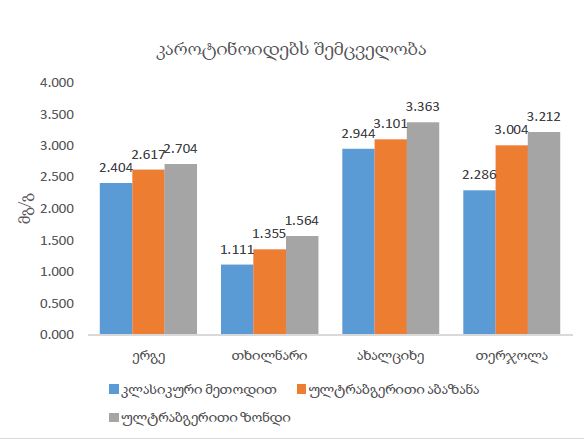Green Approaches to Carotenoid Extraction from Sea Buckthorn Fruit and Their Role in Ophthalmology

Hippophae rhamnoides L. is a valuable medicinal plant, distinguished by its rich content of bioactive compounds, mainly carotenoids and phenols. This study aimed to optimize the extraction of carotenoids from H. rhamnoides L. fruits using "green technologies" (ultrasonic bath and probe), as well as to evaluate the effect of various drying methods (atmospheric, vacuum, and freeze-drying) on carotenoid content and antioxidant activity. The research object was H. rhamnoides L. fruits, wild-growing in Western Georgia. Quantitative determination of carotenoids was carried out by the spectrophotometric method, and antioxidant activity was assessed by the DPPH radical scavenging method. The results of the study showed that ultrasonic probe extraction provides a high yield of carotenoids (1.564–3.363 mg/g dry weight), which significantly exceeds the values obtained by the classical method (1.111–2.944 mg/g). A correlation was established between carotenoid concentration and antioxidant activity. In particular, a high content of carotenoids (Akhaltsikhe, 3.363 mg/g) provides 50% inhibition of the DPPH radical with a relatively small amount of the sample (2.881 mg). Among the drying methods, freeze-drying (2.689 mg/g) and vacuum drying (2.481 mg/g) showed an advantage in preserving carotenoid content and antioxidant activity compared to atmospheric drying (1.778 mg/g). In conclusion, the use of "green technologies" is effective for obtaining bioactive compounds, which contribute to their use in ophthalmology, especially for the regeneration of eye surface damage. The data obtained forms the basis for further in vitro and in vivo studies.
Downloads
Metrics
No metrics found.
ლაგაზიძე დ. , ქუთათელაძე გ., ორჯონიკიძე მ., ბაკურიძე ა. (2023) ტექნოლოგიის გავლენა ქაცვის ზეთის გამოსავლიანობასა და ხარისხის მაჩვენებლებზე Vol. 5 Issue 2,Doi: https://doi.org/10.52340/jecm
Tie F, Dong Q, Zhu X, Ren L, Liu Z, Wang Z, Wang H, Hu N. (2024) Optimized extraction, enrichment, identification and hypoglycemic effects of triterpenoid acids from Hippophae rhamnoides L pomace. Food Chem. 1;457:140143. doi: 10.1016/j.foodchem.2024.140143. Epub 2024 Jun 16. PMID: 38901339.
Kim, S., Lee, J., Son, H., Lee, K. H., Chun, Y., Lee, J. H., Lee, T., & Yoo, H. Y. (2024). Improvement in Natural Antioxidant Recovery from Sea Buckthorn Berries Using Predictive Model-Based Optimization. Agriculture, 14(7), 1095. https://doi.org/10.3390/agriculture14071095
Zakynthinos G., Varzakas T. (2023) Carotenoids: from Plants to Food Industry. DOI : https://dx.doi.org/10.12944/CRNFSJ.4.Special-Issue1.04
Najmi, A., Javed, S. A., Al Bratty, M., & Alhazmi, H. A. (2022). Modern Approaches in the Discovery and Development of Plant-Based Natural Products and Their Analogues as Potential Therapeutic Agents. Molecules, 27(2), 349. https://doi.org/10.3390/molecules27020349
Chaachouay, N., & Zidane, L. (2024). Plant-Derived Natural Products: A Source for Drug Discovery and Development. Drugs and Drug Candidates, 3(1), 184-207. https://doi.org/10.3390/ddc3010011
Kim, Y.-J., & Kang, K. S. (2023). The Phytochemical Constituents of Medicinal Plants for the Treatment of Chronic Inflammation. Biomolecules, 13(8), 1162. https://doi.org/10.3390/biom13081162
Varzakas, T., Zakynthinos, G., & Verpoort, F. (2016). Plant Food Residues as a Source of Nutraceuticals and Functional Foods. Foods, 5(4), 88. https://doi.org/10.3390/foods5040088
Elshafie, H. S., Camele, I., & Mohamed, A. A. (2023). A Comprehensive Review on the Biological, Agricultural and Pharmaceutical Properties of Secondary Metabolites Based-Plant Origin. International Journal of Molecular Sciences, 24(4), 3266. https://doi.org/10.3390/ijms24043266
Jan, R., Asaf, S., Numan, M., Lubna, & Kim, K.-M. (2021). Plant Secondary Metabolite Biosynthesis and Transcriptional Regulation in Response to Biotic and Abiotic Stress Conditions. Agronomy, 11(5), 968. https://doi.org/10.3390/agronomy11050968
Bhardwaj, K., Silva, A. S., Atanassova, M., Sharma, R., Nepovimova, E., Musilek, K., Sharma, R., Alghuthaymi, M. A., Dhanjal, D. S., Nicoletti, M., Sharma, B., Upadhyay, N. K., Cruz-Martins, N., Bhardwaj, P., & Kuča, K. (2021). Conifers Phytochemicals: A Valuable Forest with Therapeutic Potential. Molecules, 26(10), 3005. https://doi.org/10.3390/molecules26103005
Kurz C, Carle R, Schieber A. (2008) HPLC-DAD-MS(n) characterisation of carotenoids from apricots and pumpkins for the evaluation of fruit product authenticity. Food Chem. 2008 Sep 15;110(2):522-30. doi: 10.1016/j.foodchem. PMID: 26049248
Stefan Bogdanova, Kaspar Ruoffa and Livia Persano Oddo (2004). “Physico-chemical methods for the characterisation of unifloral honeys: a review” Volume 35, European unifloral honeysPage (s) S4 - S17 DOIhttps://doi.org/10.1051/apido:2004047
Subhash Ajmani, Kamalakar Jadhav, and Sudhir A. Kulkarni 2014 “Three-Dimensional QSAR Using the k-Nearest Neighbor Method and Its Interpretation ” Journal of Saudi Chemical Society, Pages 618-625 https://doi.org/10.1016/j.jscs.2012.11.009
Copyright (c) 2025 Georgian Scientists

This work is licensed under a Creative Commons Attribution-NonCommercial-NoDerivatives 4.0 International License.





